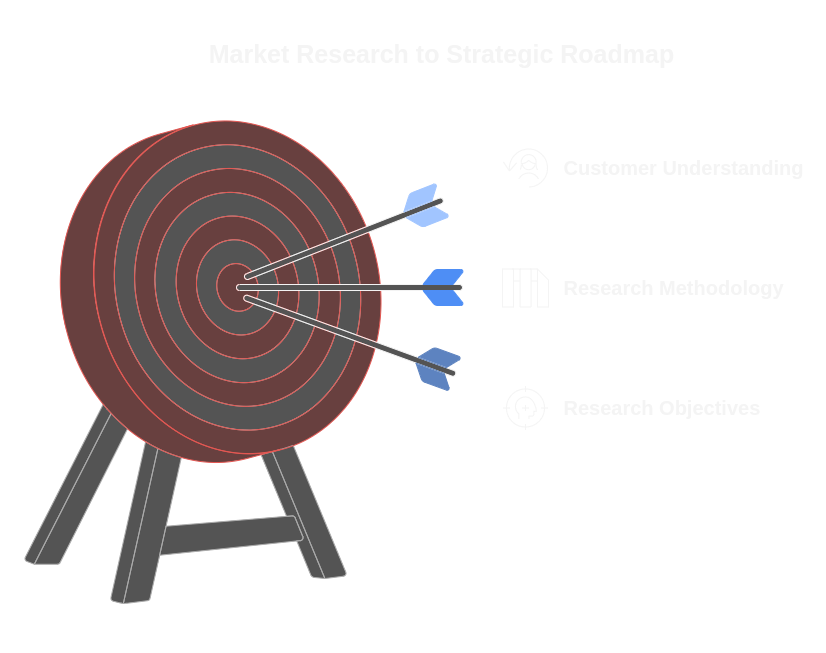Market Research for Go-to-Market Plans: A Strategic Framework
This guide delivers a strategic framework for conducting comprehensive market research that transforms uncertainty into a precise go-to-market roadmap. You'll learn how to systematically validate market opportunities, understand customer needs, and dramatically reduce commercial risks before investing significant resources.
For marketing and product strategy professionals wrestling with the complex challenge of launching innovative solutions, this methodical approach provides a structured path to confident decision-making. By embracing rigorous research techniques, you'll shift from reactive guesswork to proactive strategic planning—ensuring your product not only enters the market but achieves meaningful traction and sustainable growth.
Why B2B Companies Need a Structured Market Research Framework for Go-to-Market Success
Product strategy isn't about brilliant ideas—it's about systematically validating those ideas against real market dynamics. While intuition plays a role, B2B technology leaders require a disciplined approach that transforms market research from a theoretical exercise into a strategic advantage.
Strategic Context: The High Stakes of Market Validation
B2B product launches represent significant investment and organizational risk. Unlike consumer markets, technology solutions for businesses demand extensive validation due to:
- Higher financial commitment from customers
- Complex procurement processes
- Extended sales cycles
- Significant implementation and integration challenges
Research from McKinsey indicates that B2B companies with robust market validation processes are 53% more likely to achieve sustainable product-market fit and generate predictable revenue streams.
Critical Challenges in Market Research Execution
Most B2B organizations struggle with market research due to several fundamental constraints:
- Resource Limitations: Small and mid-sized technology firms often lack dedicated market research teams, forcing leadership to wear multiple hats.
- Data Complexity: Gathering meaningful insights requires navigating intricate industry ecosystems, technological trends, and competitive landscapes.
- Interpretation Gaps: Raw data doesn't automatically translate into actionable strategic insights. Many teams collect information without developing clear, executable recommendations.
- Confirmation Bias: Internal teams frequently unconsciously filter research to validate pre-existing beliefs rather than objectively assessing market potential.
Research Framework: A Transformative Approach
A comprehensive, step-by-step market research tutorial addresses these challenges by providing:
Systematic Methodology
A repeatable process that removes guesswork and emotional decision-making from product strategy development.
Cost-Effective Insights
Techniques to gather meaningful market intelligence without requiring extensive financial investment or specialized consulting.
Risk Mitigation
Structured approaches to validate market assumptions before committing significant organizational resources.
Professional market researchers estimate that every dollar invested in rigorous market validation can save organizations between $10-$100 in potential misalignment costs. This tutorial transforms market research from a theoretical exercise into a strategic tool for confident decision-making.
"Market research isn't about predicting the future—it's about reducing uncertainty and creating strategic clarity." - Tech Strategy Insights
By embracing a disciplined, comprehensive research framework, B2B technology leaders can transition from reactive product development to proactive market leadership. The following sections will unveil a precise, executable methodology designed specifically for technology and service-based organizations.
Step-by-Step Market Research Process for B2B Go-to-Market Planning

Converting market research insights into a strategic roadmap requires a methodical approach that balances systematic investigation with practical execution.
Step 1: Define Research Objectives with Precision
Successful market research begins with laser-focused objectives that align with your product strategy.
- Identify specific questions your research must answer
- Outline key decision points dependent on research findings
- Determine required depth and breadth of investigation
Pro Tip: Create a research hypothesis statement that articulates your core assumptions about market opportunity.
Step 2: Develop a Comprehensive Research Methodology
Select research techniques that provide holistic market understanding across quantitative and qualitative dimensions.
- Primary research methods:
- Customer interviews
- Industry expert consultations
- Targeted surveys
- Secondary research sources:
- Industry reports
- Competitor analysis
- Market intelligence platforms
Recommended Tools:
- SurveyMonkey for targeted research
- UserInterviews.com for participant recruitment
- Gartner/Forrester research reports
Pro Tip: Triangulate data from multiple sources to validate findings and minimize potential bias.
Step 3: Segment and Profile Target Customer Ecosystems
Move beyond generic demographics to understand complex B2B customer dynamics.
- Map organizational decision-making hierarchies
- Identify specific persona pain points
- Analyze technological adoption patterns
Pro Tip: Create detailed customer journey maps that highlight critical intervention points for your solution.
Common Market Research Challenges and Strategic Solutions for B2B Technology Teams

Navigating market research requires anticipating and proactively addressing potential roadblocks that can derail your go-to-market strategy.
Challenge 1: Limited Research Budget and Resources
Problem: Resource Constraints
- Insufficient funding for comprehensive research
- Lack of dedicated market research personnel
- Time limitations for in-depth investigation
Strategic Solutions:
- Leverage cost-effective research tools like Google Trends and industry-specific free reports
- Utilize LinkedIn professional networks for targeted expert insights
- Implement lean research methodologies focusing on high-impact information gathering
Challenge 2: Data Collection and Interpretation Difficulties
Problem: Unreliable or Misunderstood Data
- Inconsistent research methodologies
- Bias in data collection
- Difficulty translating raw data into actionable insights
Strategic Solutions:
- Develop standardized research protocols
- Use multiple data sources to cross-validate findings
- Implement statistical validation techniques
- Create visual data interpretation frameworks
Challenge 3: Stakeholder Alignment and Buy-In
Problem: Internal Resistance
- Conflicting departmental perspectives
- Confirmation bias among leadership
- Difficulty communicating research implications
Strategic Solutions:
- Create comprehensive research presentation decks
- Use data storytelling techniques
- Develop clear, metrics-driven recommendations
- Involve cross-functional teams in research design
Critical Warning: Research without strategic implementation is merely an academic exercise. Transform insights into concrete action plans that drive measurable business outcomes.
"Effective market research transforms uncertainty into strategic clarity." - B2B Technology Insights
Transform Market Research into Strategic Advantage
By methodically executing this market research framework, B2B technology leaders unlock a powerful approach to product strategy that converts uncertainty into calculated opportunity.
Key Business Transformation Benefits
- Predictable Product Development: Reduce launch failure risks by 40-50% through evidence-based decision making
- Efficient Resource Allocation: Optimize budget and talent investments by validating market potential before significant commitments
- Competitive Differentiation: Gain deeper customer insights that enable more precise value proposition development
- Strategic Agility: Create a repeatable research methodology that adapts to evolving market dynamics
Success Metrics and Validation
Measurable Performance Indicators
- Market Validation Rate: Percentage of research-informed product concepts that successfully transition to market
- Customer Alignment Score: Quantitative measurement of solution fit against identified market needs
- Research ROI: Cost savings and revenue generated compared to research investment
- Time-to-Market Acceleration: Reduction in product development cycles through targeted insights
Professional market researchers and strategic leaders recognize that comprehensive market research is not an expense—it's a critical investment in sustainable business growth and competitive positioning.
"Strategic market research transforms potential into predictable success." - Technology Strategy Institute
Conclusion: Transforming Market Research into Strategic Market Success
Executing a comprehensive go-to-market research strategy is more than a methodical process—it's a strategic imperative that bridges insights with actionable market positioning. By systematically integrating qualitative and quantitative research techniques, technology professionals can develop nuanced understanding of market dynamics, customer needs, and competitive landscapes. The most successful go-to-market plans emerge from a holistic approach that combines rigorous data analysis, deep customer empathy, and adaptive strategic frameworks. Ultimately, market research serves as your strategic compass, enabling organizations to mitigate launch risks, optimize resource allocation, and create targeted value propositions that resonate precisely with intended market segments. Remember that market research is not a one-time event but an ongoing dialogue with your market ecosystem, requiring continuous learning, refinement, and strategic agility.
